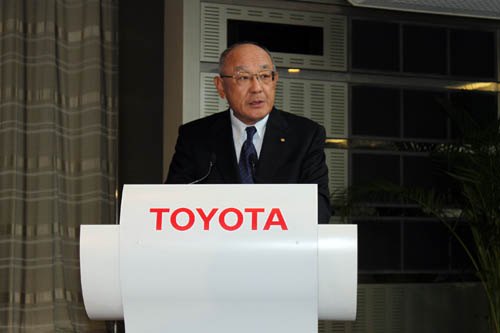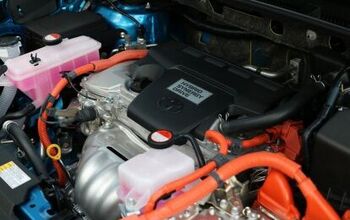Toyota Wants To Learn From Nissan

None of the approximately 100 journalists that packed Toyota’s basement meeting room in Tokyo today was surprised when the midterm results of the current fiscal year were announced, and there was an operating loss of 32.6 billion yen ($417 million). The loss was a little higher than expected, but expected it was. If you lose 689,000 units in sales, then you are bound to lose some money. The surprise came in the form of an unexpected new benchmark: Nissan.
Usually, no competitor is mentioned in public by name. Today, Toyota’s CFO Satoshi Ozawa named Nissan at least twice as an example worth following. Looking at the way Nissan handled the earthquake and the floods in Thailand, Ozawa said:
“It seems that Nissan has run their operations wiser than Toyota has done. If there is something we can learn from their example, then there is some homework for us to do.”
Five minutes later, Ozawa admires Nissan again:
“In terms of what happened after the earthquake or the Thai flooding, it seems Nissan suffered less than Toyota. If there is something there to learn from, we’d like to do that.”
Unsaid, but evident: There is a much bigger disaster which Nissan handles better than Toyota: The soaring yen. Toyota makes 3 million cars in Japan, and more than half of them are exported. Nissan also exports more than half of its Japanese production. However, this is down to a million units annually. Despite earthquake and yen, Nissan recorded an operating profit of 309.7 billion yen (US $3.88 billion) in the first six months of the fiscal, while Toyota lost money.
Nissan’s Ghosn had taken the lead in rallying against the “abnormal yen.” On Monday, Japan’s manufacturer association JAMA joined in. At a JAMA press conference, Akio Toyoda, who is also vice chairman JAMA, urged the government to immediately address the strong yen, and said the government “must do something to stop the manufacturing base from collapsing.”
Nevertheless, Toyota is sticking to the concept of making 3 million cars at home, literally at all costs. Complicated calisthenics are needed to maintain that level. Currently, 1.3 million cars are sold domestically, and 1.7 million are exported. In the future, the relationship is planned to go to 1.5 million sold at home and 1.5 shipped abroad. Toyota is looking to the Japanese government for a lower vehicle tax to crank up flagging domestic sales. Currently, most power trains are made in Japan and shipped abroad. “We will make more efforts to produce them outside of Japan,” Ozawa said.
For the second time this year, Toyota did not make a forecast for the rest of the year. The first time was after the March 11 tsunami. This time, Toyota is unable to fully quantify the effects of the Thai floods. As of the end of this week, the floods in Thailand will have cost 150,000 unproduced cars.

Bertel Schmitt comes back to journalism after taking a 35 year break in advertising and marketing. He ran and owned advertising agencies in Duesseldorf, Germany, and New York City. Volkswagen A.G. was Bertel's most important corporate account. Schmitt's advertising and marketing career touched many corners of the industry with a special focus on automotive products and services. Since 2004, he lives in Japan and China with his wife <a href="http://www.tomokoandbertel.com"> Tomoko </a>. Bertel Schmitt is a founding board member of the <a href="http://www.offshoresuperseries.com"> Offshore Super Series </a>, an American offshore powerboat racing organization. He is co-owner of the racing team Typhoon.
More by Bertel Schmitt
Latest Car Reviews
Read moreLatest Product Reviews
Read moreRecent Comments
- Daniel J 19 inch wheels on an Elantra? Jeebus. I have 19s on my Mazda 6 and honestly wish they were 18s. I mean, I just picked up 4 tires at over 1000 bucks. The point of an Elantra is for it to be cheap. Put some 17s on it.
- ToolGuy 9 miles a day for 20 years. You didn't drive it, why should I? 😉
- Brian Uchida Laguna Seca, corkscrew, (drying track off in rental car prior to Superbike test session), at speed - turn 9 big Willow Springs racing a motorcycle,- at greater speed (but riding shotgun) - The Carrousel at Sears Point in a 1981 PA9 Osella 2 litre FIA racer with Eddie Lawson at the wheel! (apologies for not being brief!)
- Mister It wasn't helped any by the horrible fuel economy for what it was... something like 22mpg city, iirc.
- Lorenzo I shop for all-season tires that have good wet and dry pavement grip and use them year-round. Nothing works on black ice, and I stopped driving in snow long ago - I'll wait until the streets and highways are plowed, when all-seasons are good enough. After all, I don't live in Canada or deep in the snow zone.




































Comments
Join the conversation
Bertel - you write "Nevertheless, Toyota is sticking to the concept of making 3 million cars at home, literally at all costs." Why is Toyota so fixed on producing 3 million in Japan? Is it to do with saving face, or national pride, or....?
They'll pull through, unlike GM they're not on the guv-ment teat and bogged down by the God damn UAW.